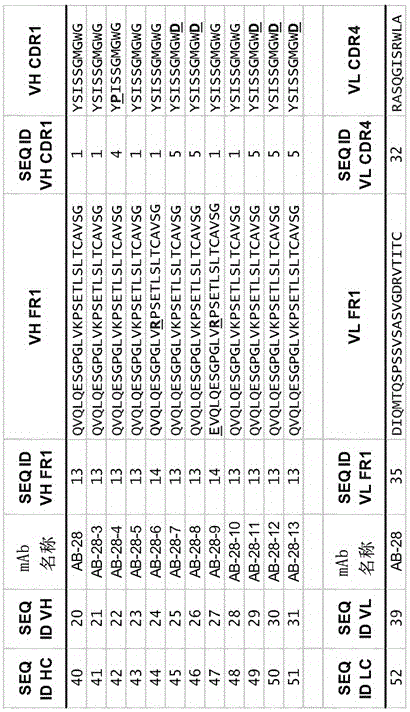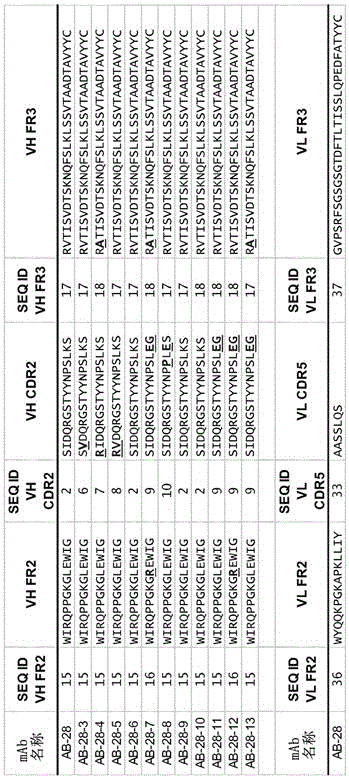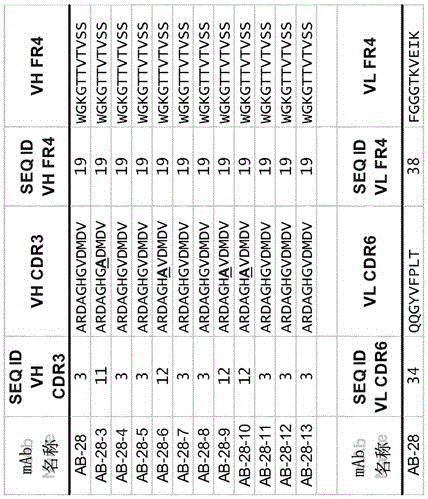Cross-reactive staphylococcus aureus antibody sequences
A staphylococcus, golden yellow technology, applied in the direction of antibodies, antibody medical components, antibacterial drugs, etc., can solve problems such as unreported toxin cross-reactive mAbs
- Summary
- Abstract
- Description
- Claims
- Application Information
AI Technical Summary
Problems solved by technology
Method used
Image
Examples
example 1
[0606] Example 1 Generation of Hla–two-component toxin cross-reactive mAbs that bind to a single toxin component with high affinity
[0607] method:
[0608] Production of recombinant toxins. The genes of S-component and F-component are derived from TCH1516USA300 bacterial strain, codon optimization is used for Escherichia coli expression, produces (Genescript, USA) by gene synthesis, (see Figure 7 ), cloned as pET44a, produced protein in BL21, Rosetta or Tuner DE3 strains without signal peptide sequence (determined by PrediSi program; Hiller, Nucleic Acids Res., 2004, 32: W375-W379).
[0609] LukS, LukF, LukE, LukD, HlgA, HlgC and HlgB expressed in soluble form with N-terminal NusA / His 6 marker, which is proteolytically removed after the first purification step. Purification usually involves three chromatographic steps 1) IMAC (immobilized metal ion affinity column) 2) cation exchange or IMAC, and 3) size exclusion chromatography. Clarified cell extracts were loaded ...
example 2
[0615] Example 2H1a - Improved Binding Affinity of Two-Component Toxin Cross-Reactive mAbs to LukF and LukD in vitro toxin neutralizing potency
[0616] method:
[0617] In vitro assay of toxin-mediated cell lysis. Toxin potency in target cells was assessed by measuring ATP levels in intoxicated cells (polymorphonuclear cells (PMN), differentiated HL60 or A549 cells). Briefly, HIa or equimolar mixtures of F- and S-components were serially diluted in assay medium for intoxication of cells. Then, using a commercial kit (Cell Luminescent Cell Viability Assay; Promega, USA), the cell viability of PMN, differentiated HL60 and A549 cells was determined according to the manufacturer's instructions. % survival was calculated relative to the mock-treated control.
[0618] For Hla, two different in vitro assays were performed using the human lung epithelial cell line A549 or rabbit erythrocytes. The day before, A549 cells (HPACC#86012804) were trypsinized and cultured at a den...
example 3
[0628] Example 3H1a - Improvement of the binding affinity of two-component toxin cross-reactive mAbs to LukF and LukD In vivo protection
[0629] method:
[0630] Passive protection of mice by monoclonal antibodies. The protective effect of anti-S. aureus antibodies was evaluated in several murine models. Passive immunization with mAbs was performed intraperitoneally 24 hours before lethal challenge with recombinant toxin. A group of 5 mice (BALB / c) each received a single mAbs dilution in PBS at a dose of 5 or 10 mg / kg (100 or 200 ug / mouse, respectively). Control groups received only PBS or the same dose of isotype-matched non-specific mAb. Toxin challenges were performed using HlgA-HlgB or HlgA-LukD toxin pairs at doses of 0.2 and 1 ug per mouse (each component), respectively.
[0631] result:
[0632] Such as Figure 4 mAbs AB-28-3 (K D =18pM) and AB-28-9 (K D = 5 pM) showed that cross-reactive Hla mAbs that bind to HlgB with an affinity <20 pM were very effe...
PUM
| Property | Measurement | Unit |
|---|---|---|
| affinity | aaaaa | aaaaa |
Abstract
Description
Claims
Application Information
 Login to View More
Login to View More - R&D
- Intellectual Property
- Life Sciences
- Materials
- Tech Scout
- Unparalleled Data Quality
- Higher Quality Content
- 60% Fewer Hallucinations
Browse by: Latest US Patents, China's latest patents, Technical Efficacy Thesaurus, Application Domain, Technology Topic, Popular Technical Reports.
© 2025 PatSnap. All rights reserved.Legal|Privacy policy|Modern Slavery Act Transparency Statement|Sitemap|About US| Contact US: help@patsnap.com



